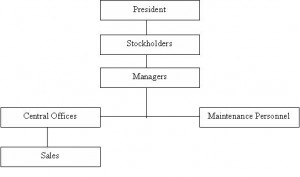Excerpt from the proposed telephone industry business.
Management study includes the planning, organizing, staffing and directing of the project. Also it includes the external activities in starting the business. The means and procedure are undertaken before the operation of the business. The form of management is indicated identifying each of management and each personnel. The role and duties of each personnel is clearly defined, as well as practice and develop skills learned from this project
Management Analysis
Our business covers a system of services that can be determined in large scales. A corporation owns the ETHECOM. This kind of business has a very large management. The management and operation of the business are determined and constructed by the joint-forces and capabilities of the corporate members and staffs.
Organization Chart
ETHELCOM provides its organizational line chart, compose of personnel deployed within the business.

Registration of business
The registration of business is an act that is provided by the constitution. It is very important and must be implemented in order for the business to be legal and to perform well and freely.
The following are the steps for registering a business in the Philippines.
- Prepare the article of partnership/corporation.
- Registration of the business name with the Bureau of Domestic Trade and Industry.
- Apply the registration of the partnership with the Securities and Exchange Commission.
- Get the necessary permit from the office of the mayor and license to operate from the treasure of the city of municipality where the business will be located.
- Secure a tax identification from the Bureau of Internal Revenue and a file VAT or Not-VAT permit.
Hiring Personnel
The following are the qualification for the interested job seekers.
Electronics and Communication Engineer
– Preferably Male, 22-30 yrs. old
– Licensed
– At least 5 years of experience
Technician
– Preferably Male, 22-30 yrs. Old
– BSECE or Electronics/ Electrical graduate
– At least 3 years of experience in the related field
Sales
– Male or Female, 21-30 yrs. old
– High School Graduate
– With pleasing personality
Job Description and Responsibilities
President
– Responsible in making final decision for every undertaking the business may encounter.
– Administer over all activities and for sees projects, forecast, and solve problems.
Manager (Stockholders)
– To assist the President and his duties and responsibilities.
– Must be responsible in assigning different task of each personnel.
– Responsible for preparing financial statement of the business.
Purchasing Personnel
– Responsible for good quality of purchased products
– Responsible for purchasing low cost of product
– Responsible for scheduling of purchased product
Technicians
– Responsible for repairing, servicing and installation
Sales Personnel
– Responsible for the sales of product, operational reliability of services and provides customer care.
